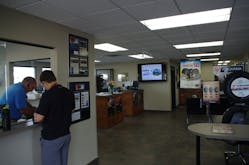There’s a lot you can tell by looking into the eyes of your staff. If you’re lucky, you’ll see enthusiasm, dedication and energy. What you don’t want is weariness, boredom and apathy. Couple the latter with work habits that demonstrate loss of interest (tardiness, mistakes, carelessness, etc.), and you have a serious problem on your hands. An equally grim scenario is having staff members who haven’t demonstrated they’re losing interest, but who have begun looking outside your doors for their next career move.
Employee engagement—it’s a significant issue in every workplace. Some human resource studies indicate an average of 15 percent of employees in most businesses have disengaged from their employers. They no longer feel that they’re a part of a business and have little interest in growing it since they see no future there themselves. Considering the average shop has 15-20 workers, that’s 2-3 employees looking to move on, which translates into an enormous problem in an industry already struggling to replace an aging workforce.
Fortunately, with some big problems sometimes come proven solutions. That’s the case with reengaging employees. What follows are steps contributed from human resource professionals to reenergize your employees, along with real-world example from shops benefitting from policies intended to keep the light in their employees’ eyes from burning out.
Setting the stage
Before using any of the following in your shop, keep in mind that quick fixes don’t work when it comes to helping workers get their groove back. The goal here is to implement steps that transform your business culture into one that continually connects with employees, reminding them of their significance and giving them opportunities to grow within your operation.
1. Listen more
Communicate more! You’ve all heard that suggestion many times before. Because owners/managers are so used to giving direction, they often misinterpret this to mean talk more—which is good if you’re giving employees information and guidance they want. But you also have to listen more, much more. This means keeping your mouth temporarily shut and allowing workers the time to speak what’s on their minds. It also means delving into what an employee is saying by asking questions and making sure you communicate that (1) you’re genuinely interested in what’s being said and (2) are taking it into consideration.
It’s all too easy for employees to lose interest in a workplace where one’s voice isn’t being heard. Counter this by developing your listening skills—encourage feedback, take notes, if necessary, and always follow up. Just as important, when possible, put this feedback into action. Shops thrive on new ideas. Employees can be your best resource for the latest industry trends or for workplace changes that make your operation run smoother.
When you listen, you’re continuously building important relationships with employees and potentially building your business—two things that go a long way in keeping a staff engaged.
2. Set clear expectations
“I really don’t know what they want from me.” Such is the refrain of employees who feel either lost or isolated in the workplace. Flying solo works only for a minority of workers. Most require and want crystal clear goals.
Performing collision repairs, like any other job, involves much more than simply handling the task at hand. Employees need additional guidance on what the expectations are both for their role and their place in the business. Above all, they need to know what you consider success.
This will vary from one workplace to another, but success-oriented expectations can include setting standards for how many labor hours you expect during each work hour, number of estimates written, business opportunities captured or parts painted. Along with this can be baselines for CSI scores, revenue and cycle times. The point is giving employees a way to grade themselves in the workplace so they know how they fit in.
From there, regularly show employees how they fit into your business’s plans. Provide a detailed, big picture description of your business and the direction you wish to take it. Describe how each employee will contribute to this vision and how in turn each will benefit. “Keep in mind that most employees want more than just a paycheck,” says Kathy Beckworth, owner of Great Mornings HR Solutions. “They want to feel needed and significant. Providing clear expectations helps them understand that they have a place in the business’s driver’s seat.”
3. Set goals together
One of the best ways to help employees meet expectations and take their turn at the wheel is working with them on goals. Engaged employees are empowered employees. To empower yours, ask for their suggestions on how they should reach annual (or mid-year) goals. For example, if you’re looking to raise shop wide baselines on labor hours, ask your techs for input on what would help them increase output.
“When we were looking for ways to help our shop turn the corner, we turned to our employees to help with planning. The best way to approach that was in the first quarter when we sat down with each to go over personal goals,” explains Ray Anthony, owner of Beachcraft Collision in Los Angeles. “We found that by asking each of our guys what he wanted to do to help the shop and himself, we could work out a solution that benefitted everyone.”
Anthony adds, “When you give employees a chance to set their own course, they begin owning their work. It becomes more meaningful because it’s what they want. It really changes attitudes."
Beckworth recommends asking employees to set one personal goal outside their normal work responsibilities. This can be anything from training or reading books on personal improvement. “If you want to appeal to your employees, engage with the person. Help them build skills and qualities they can benefit from at work and at home.”
4. Use KPIs the right way
KPIs provide terrific insights into where shops can improve and where individual employees are succeeding or falling short. Plenty of shops rave about the positive impact KPIs can have when it comes to setting employee benchmarks and goals and creating healthy competition among workers (when scores are publically posted). This practice can have a downside.
“You risk alienating people,” says Beckworth. “KPIs can have tremendous value for an organization, but you have to tread lightly and watch that you don’t turn performance into a numbers game. There’s nothing wrong with setting standards, but you need to communicate to employees their worth is more than just a series of measurements.”
Other critics warn that too much focus on KPIs can further isolate employees as they look to outdo one another rather than working together as colleagues. Engagement and personal growth suffer at the expense of hitting and passing numerical targets. The result can be a contentious, unfriendly environment that workers will want to flee
Beckworth says shops need to find a healthy medium where KPIs are involved but aren’t the sole or overriding measurement. “Use your KPIs to improve specific skills,” she says. “Work with employees to turn weaknesses into strengths. Let them know you’re using these numbers to help them, so they’ll see them as a valuable resource for self-improvement.”
“Studies show that doing so boosts KPIs. In fact, the best way to grow scores is by cultivating personal investment in the work,” Beckworth adds.
5. Embrace opportunity
Think about the jobs where you were most unhappy. Odds are they were dead end positions (not necessarily low paying) that wouldn’t have led to more fulfilling roles. You weren’t happy because you weren’t satisfied or, perhaps more specifically, you didn’t have the opportunity to show off talents and skills that you found fulfilling. That’s the case for many disengaged employees.
They may be fine with performing their current tasks for a while, but at some point they need challenged with new opportunities. These opportunities can be anything from switching roles—for example, from tech to estimator, detailer to painter, or customer service associate to marketing guru—or moving up through the managerial ranks. The best way to facilitate career opportunities is by building a culture of opportunity where you encourage employees to take their next career step.
One of keystones of this culture is cross training. Often, employees allow themselves to get stuck in unfulfilling careers because they aren’t entirely sure of what else they’d like to do. Giving them the chance to add skills and experience also provides them with the opportunity to discover new roles they’d like to pursue. Some shops have built their success on this notion.
Warrensburg Collision in Warrensburg, Mo., provides workers with position functionality so they can fill a variety of roles. Manager Casey Lund also has asked all employees to learn how to use the shop’s management system. This system contributed to Warrensburg tripling its revenue it just three years.
Also keep in mind that providing career opportunities doesn’t necessarily mean putting employees in different positions. Sometimes all you have to do is offer new tasks. Techs and painters with a flair for the artistic could be drawn to custom work. Employees who enjoy writing can contribute to your Website and social media content with postings, new ideas and blogs. Any number of your workers might be excited to pick up technology skills related to diagnosing and calibrating sensors.
6. Add the human element
While you’re inviting employees to gain a wider perspective of collision operations, boost their interest in work even more by providing one additional perspective—the customer’s. Doing this goes well beyond announcing CSI scores.
Beckworth says one of the most overlooked aspects of employee satisfaction is how their work affects the lives of others. Plenty of repairers declare that the collision industry is a “people business” or that they’re “in the business of repairing people, not just cars,” but many shop workers frequently are removed from the very customers they’re servicing. They don’t get the fulfillment of helping another human being.
Remedy this by communicating some of the details of each job when applicable—for example, you’re getting a single mom back on the road, helping a family resume its normal routine or returning a much-loved vehicle to a retiree. Ask your customers for feedback. Share positive comments, or at the very minimum, regularly remind employees how much their service means to customers so you can put a face on every job.
Indeed, human resource professionals note the strong link between employee engagement and the knowledge of how staff contributions resonate well beyond shop doors.
It’s your move
Taking steps like these involves a serious commitment from you and your shop’s management. That involves time, no small commodity in the world of collision repairs. But that shouldn’t be a deal breaker. Think of it this way. You can either invest time and interest to keep your staff engaged and reap the benefits of dedicated, enthusiastic employees or spend even more time and resources seeking replacements while hoping they stay around long enough to help you maintain your current pace. Thrive or survive? Revitalize or subsist?
The better choice seems pretty obvious.




